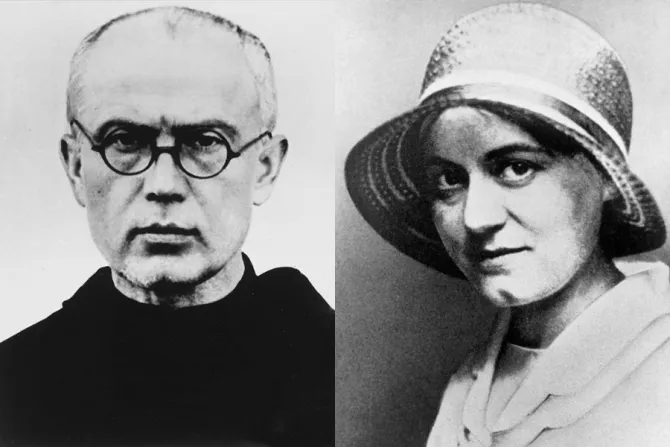Rome, Italy, Jul 29, 2016 / 11:20 am
Pope Francis sat quietly in one of Auschwitz’s most ominous prison cells, praying in what had been the inhumane living space of St. Maximilian Kolbe, a Catholic priest martyred during the Holocaust.
St. Maximilian was one of over a million people estimated to have died in the Auschwitz concentration camps, where the pope paid a visit on July 29 during his trip to Poland. This August marks the 75th anniversary of his death.
Although the majority of those incarcerated in the death camps were Jews, targeted by the Nazi regime for extermination, many of the victims were Catholics, including priests and religious sisters. St. Maximilian, a Franciscan friar, died in 1941 after asking to take the place of another prisoner who was destined for execution. The following year, Edith Stein, the German Jewish philosopher turned Catholic Carmelite nun, was also killed at Auschwitz, most likely in the gas chambers upon her arrival.
They are joined by countless other Catholics who lost their lives during the Holocaust, many of them for trying to rescue Jews from the Nazis.
The sacrifices of these Catholics, both living and dead, were quietly remembered throughout Pope Francis’ pilgrimage to the infamous Auschwitz death camp. He prayed at length in the prison cell where St. Maximilian had been kept during his incarceration. He also greeted a group known as the “Righteous among the Nations” — non-Jewish men and women who had risked their lives to save Jews from the Nazi extermination.
According to several biographies, the young St. Maximilian had been personally called to martyrdom by the Virgin Mary. In his account, Mary came to him in an apparition holding two crowns, indicating for him to choose: one was white, representing purity, the other red, for martyrdom. He chose both.
Following the German invasion of Poland, St. Maximilian was arrested twice, first in 1939 and again in 1941, at which point he was sent to Auschwitz. That August, 10 prisoners were sentenced to death by starvation in punishment for another inmate’s escape. After hearing one of the men lament leaving behind his wife and children, Father Kolbe volunteered to die in his place.
Survivors of the camp testified that the starving prisoners could be heard praying and singing hymns, led by the priest. After two weeks, on the night before the feast of the Assumption of the Blessed Virgin Mary, the camp officials decided to hasten Kolbe’s death, injecting him with carbolic acid. He was canonized 40 years later, on Oct. 10, 1982.
Edith Stein, known formally as St. Teresa Benedicta of the Cross, is another martyr of the Auschwitz death camp. She was born into a Jewish family in Breslau, Poland, but abandoned her faith as a teenager. A brilliant academic, Stein advanced in a career in philosophy and studied under the likes of phenomenologists Edmund Husserl and Martin Heidegger. Influenced by the writings of St. Teresa of Ávila, she converted to Catholicism in 1922, and entered the disclaced Carmelite monastery 1933.
In 1942, Sister Teresa Benedicta was arrested along with her sister Rosa and the members of her religious community in retaliation against a protest letter by the Dutch bishops, which decried the Nazi treatment of Jews. It is believed that she perished in the Auschwitz gas chambers upon her arrival Aug. 9, 1942, along with her sister and the rest of the community.
Pope Francis’ pilgrimage to Auschwitz also paid homage to the sacrifice of the Ulma family, even though they were not killed in the concentration camp.
The visit was conducted almost entirely in silence, except for the recitation of Psalm 130 — “Out of the depths I cry to you, O Lord” — delivered by Father Stanislaw Ruszala, a Polish priest from the village of Markowa, where the young Catholic family had been slaughtered by the Nazis for harboring Jews.
Jozef Ulma was murdered during the Nazi occupation, alongside his wife, Wiktoria, and seven children, including their unborn child. The Nazis also slaughtered the eight members of the Jewish Goldman, Gruenfeld, and Didner families being harbored by the Ulmas.
Pope Francis is not the first pontiff to visit the Auschwitz camps. The camps were visited by Polish-born St. John Paul II in 1979 and later by Benedict XVI in 2006.



